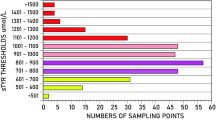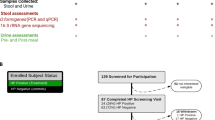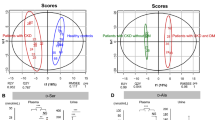Abstract
Objective:
The essential amino acid L-methionine is a potential compound in the prophylaxis of recurrent or relapsing urinary tract infection due to acidification of urine. As an intermediate of L-methionine metabolism, homocysteine is formed. The objective was to study the metabolism of L-methionine and homocysteine, and to assess whether there are differences between patients with chronic urinary tract infection and healthy control subjects.
Design:
A randomized placebo-controlled double-blind intervention study with cross-over design.
Setting:
Department of Nutritional Physiology, Institute of Nutrition in cooperation with the Department of Internal Medicine III, Friedrich Schiller University of Jena, Germany.
Subjects:
Eight female patients with chronic urinary tract infection and 12 healthy women (controls).
Interventions:
After a methionine-loading test, the volunteers received 500 mg L-methionine or a placebo three times daily for 4 weeks.
Main outcome measures:
Serum and urinary concentrations of methionine, homocysteine, cystathionine, cystine, serine, glycine and serum concentrations of vitamin B12, B6 and the state of folate.
Results:
Homocysteine plasma concentrations increased from 9.4±2.7 μmol/l (patients) and 8.9±1.8 μmol/l (controls) in the placebo period to 11.2±4.1 μmol/l (P=0.031) and 11.0±2.3 μmol/l (P=0.000), respectively, during L-methionine supplementation. There were significant increases in serum methionine (53.6±22.0 μmol/l; P=0.003; n=20) and cystathionine (0.62±0.30 μmol/l; P=0.000; n=20) concentrations compared with the placebo period (33.0±12.0 and 0.30±0.10 μmol/l; n=20). Simultaneously, renal excretion of methionine and homocysteine was significantly higher during L-methionine intake.
Conclusions:
Despite an adequate vitamin status, the supplementation of 1500 mg of L-methionine daily significantly increases homocysteine plasma concentrations by an average of 2.0 μmol/l in patients and in control subjects. An optimal vitamin supplementation, especially with folate, might prevent such an increase.
This is a preview of subscription content, access via your institution
Access options
Subscribe to this journal
Receive 12 print issues and online access
$259.00 per year
only $21.58 per issue
Buy this article
- Purchase on Springer Link
- Instant access to full article PDF
Prices may be subject to local taxes which are calculated during checkout



Similar content being viewed by others
References
Abe M, Iriki T, Koresawa Y, Inoue K & Funaba M (1999): Adverse effects of excess DL-methionine in calves with different body weights. J. Anim. Sci. 77, 2837–2845.
Andersson A, Brattström L, Israelsson B, Isaksson A & Hultberg B (1990): The effect of excess daily methionine intake on plasma homocysteine after methionine loading test in humans. Clin. Chim. Acta 192, 69–76.
Andersson A, Brattström L, Israelsson B, Isaksson A, Hamfelt A & Hultberg B (1992): Plasma homocysteine before and after methionine loading with regard to age, gender, and menopausal status. Eur. J. Clin. Invest. 22, 79–87.
Bellamy MF, McDowell IFW, Ramsey MW, Brownlee M, Bones C, Newcombe RG & Lewis MJ (1998): Hyperhomocysteinemia after oral methionine load acutely impairs endothelial function in healthy adults. Circulation 98, 1848–1852.
Cafolla A, Dragoni F, Girelli G, Tosti ME, Costante A, De Luca AM, Funaro D & Scott CS (2002): Effect of folic acid and vitamin C supplementation on folate status and homocysteine level: a randomised controlled trial in Italian smoker-blood donors. Atherosclerosis 163, 105–111.
Candito M, Bedoucha P, Mahagne MH, Scavini G & Chatel M (1997): Total plasma homocysteine determination by liquid chromatography before and after methionine loading. Results in cerebrovascular disease. J. Chromatogr. B 692, 213–216.
Fünfstück R, Straube E, Schildbach O & Tietz U (1997): Prevention of recurrent urinary tract infection by L-methionine. Med. Klin. 92, 574–581.
Hankey GJ & Eikelboom JW (1999): Homocysteine and vascular disease. Lancet 354, 407–413.
Haulrik N, Toubro S, Dyerberg J, Stender S, Skov AR & Astrup A (2002): Effect of protein and methionine intakes on plasma homocysteine concentrations: a 6-mo randomized controlled trial in overweight subjects. Am. J. Clin. Nutr. 76, 1202–1206.
Houcher B, Candito M, Gibelin P, Caramella A, De Courcy GP, Naimi D, Lefebvre JC & Van Obberghen E (2003): Assessment of folate status: measurement of homocysteine versus vitamin B12 and folate. Pteridines 14, 27–33.
Huang YC, Chang SJ, Chiu YT, Chang HH & Cheng CH (2003): The status of plasma homocysteine and related B-vitamins in healthy young vegetarians and nonvegetarians. Eur. J. Nutr. 42, 84–90.
Kato I, Dnistrian AM, Schwartz M, Toniolo P, Koenig K, Shore RE, Zeleniuch-Jacquotte A, Akhmedkhanov A & Riboli E (1999): Epidemiologic correlates of serum folate and homocysteine levels among useres and non-users of vitamin supplement. Int. J. Vit. Nutr. Res. 69, 322–329.
Krupková-Meixnerová L, Vesela K, Vítová A, Janošíkovíá B, Anděl M & Kožich V (2002): Methionine-loading test: evaluation of adverse effects and safety in an epidemiological study. Clin. Nutr. 21, 151–156.
Lim HS & Heo YR (2002): Plasma total homocysteine, folate, and vitamin B12 status in Korean adults. J. Nutr. Sci. Vitaminol. 48, 290–297.
Miller JW, Green R, Herbert VD & Flynn MA (1999): Oral vitamin B12 supplementation decreases homocysteine in healthy elderly people with suboptimal vitamin B12 status. FASEB J. 13, A936–A936.
Mudd SH & Poole JR (1975): Labile methyl balances for normal humans on various dietary regimes. Metabolism 24, 721–735.
Nygård O, Refsum H, Ueland PM & Vollset SE (1998): Major lifestyle determinants of plasma total homocysteine distribution: the Hordaland Homocysteine Study. Am. J. Clin. Nutr. 67, 263–270.
Pavia C, Ferrer I, Valla C, Artuch R, Colome C & Vilaseca MA (2000): Total homocysteine in patients with type 1 diabetes. Diabetes Care 23, 84–87.
Perna AF, Ingrosso D, Lombardi C, Cesare CM, Acantora F, Satta E & De Santo NG (2003): Homocysteine in uremia. Am. J. Kidney Dis. 41, S123–S126.
Riddell LJ, Chisholm A, Williams S & Mann JI (2000): Dietary strategies for lowering homocysteine concentrations. Am. J. Clin. Nutr. 71, 1448–1454.
Samman S, Sivarajah G, Man JC, Ahmad ZI, Petocz P & Caterson ID (2003): A mixed fruit and vegetable concentrate increases plasma antioxidant vitamins and folate and lowers plasma homocysteine in men. J. Nutr. 133, 2188–2193.
Stabler SP, Lindenbaum J, Savage DG & Allen RH (1993): Elevation of serum cystathionine levels in patients with cobalamin and folate deficiency. Blood 81, 3404–3413.
Tapola NS, Karvonen HM, Niskanen LK & Sarkkinen ES (2004): Mineral water fortified with folic acid, vitamins B6, B12, D and calcium improves folate status and decreases plasma homocysteine concentrations in men and women. Eur. J. Clin. Nutr. 58, 376–385.
Ubbink JB, Vermaak WJH, Van der Merwe A, Becker PJ, Delport R & Potgieter HC (1994): Vitamin requirements for the treatment of hyperhomocysteinemia in humans. J. Nutr. 124, 1927–1933.
Ubbink JB, Fehily AM, Pickering J, Elwood PC & Vermaak WJ (1998): Homocysteine and ischaemic heart disease in the Caephilly cohort. Atherosclerosis 140, 349–356.
Ueland PM, Refsum H, Beresford SAA & Vollset SE (2000): The controversy over homocysteine and cardiovascular risk. Am. J. Clin. Nutr. 72, 324–332.
Van Guldener C, Janssen MJFM, De Meer K, Donker AJM & Stehouwer CDA (1999): Effect of folic acid and betaine on fasting and postmethionine-loading plasma homocysteine and methionine levels in chronic haemodialysis patients. J. Intern. Med. 245, 175–183.
Vester B & Rasmussen K (1991): High performance liquid chromatography method for rapid and accurate determination of homocysteine in plasma and serum. Eur. J. Clin. Chem. Clin. Biochem. 29, 549–554.
Vollset SE, Refsum H, Tverdal A, Nygård O, Nordrehaug JE, Tell GS & Ueland PM (2001): Plasma total homocysteine and cardiovascular and noncardiovascular mortality: the Hordaland Homocysteine Study. Am. J. Clin. Nutr. 74, 130–136.
Ward M, McNulty H, Pentieva K, McPartlin J, Strain JJ, Weir DG & Scott JM (2000): Fluctuations in dietary methionine intake do not alter plasma homocysteine concentration in healthy men. J. Nutr. 130, 2653–2657.
Ward M, McNulty H, McPartlin J, Strain JJ, Weir DG & Scott JM (2001): Effect of supplemental methionine on plasma homocysteine concentrations in healthy men: a preliminary study. Int. J. Vitam. Nutr. Res. 71, 82–86.
Wilms S (1984): Harnsäuerung—wirksames Prinzip zur Verhütung folgenschwerer Entzündungen der ableitenden Harnwege und der Nieren. Therapiewoche 34, 6574–6580.
Yamaguchi K (1990): Nutrition and metabolism of sulfur amino acids. In Nutrition: Proteins and Amino Acids ed. Yoshida A, Naito H, Niiyama Y & Suzuki T, pp 165–183. Tokyo: Japan Sci Soc Press, Berlin: Springer-Verlag.
Author information
Authors and Affiliations
Corresponding author
Additional information
Guarantor: G Jahreis.
Contributors: BD: conception, design, conduct of the study, analysis, statistics, data interpretation, writing the manuscript; RF: conception, design, medical attendance; MB: analysis, data interpretation; RS: analysis, data interpretation, statistics; JG: medical attendance; GJ: conception, design, data interpretation.
Rights and permissions
About this article
Cite this article
Ditscheid, B., Fünfstück, R., Busch, M. et al. Effect of L-methionine supplementation on plasma homocysteine and other free amino acids: a placebo-controlled double-blind cross-over study. Eur J Clin Nutr 59, 768–775 (2005). https://doi.org/10.1038/sj.ejcn.1602138
Received:
Revised:
Accepted:
Published:
Issue Date:
DOI: https://doi.org/10.1038/sj.ejcn.1602138
Keywords
This article is cited by
-
Amino acid profiles: exploring their diagnostic and pathophysiological significance in hypertension
Molecular Biology Reports (2024)
-
Identification of small molecules targeting homoserine acetyl transferase from Mycobacterium tuberculosis and Staphylococcus aureus
Scientific Reports (2022)
-
Behandlung rezidivierender Harnwegsinfekte bei PatientInnen mit neurogener Blasenfunktionsstörung
Journal für Urologie und Urogynäkologie/Österreich (2022)
-
Behandlung rezidivierender Harnwegsinfekte bei PatientInnen mit neurogener Blasenfunktionsstörung
Urologie in der Praxis (2021)
-
Impact of Nutritional Epigenetics in Essential Hypertension: Targeting microRNAs in the Gut-Liver Axis
Current Hypertension Reports (2021)



